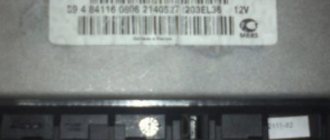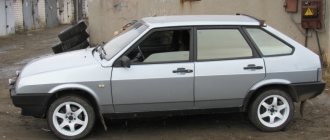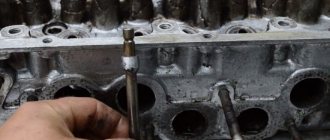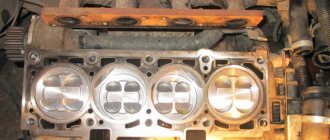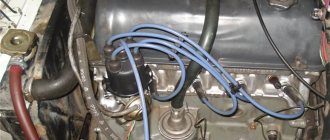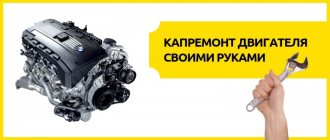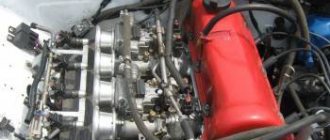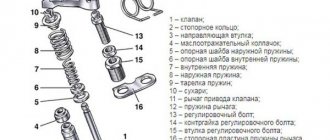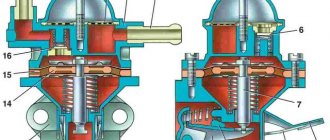As you know, the engine cylinder block is the basis of any internal combustion engine. In fact, the block is a three-dimensional part, inside of which various components and mechanisms are located (pistons and rings, as well as CPG liners, crankshaft, crankshaft connecting rods, etc.).
Also, a cylinder head is installed on the cylinder block through a gasket, which is a “continuation” of the block. The timing belt is located in the cylinder head. At the same time, both the components inside the block and in the cylinder head are subject to significant mechanical and thermal loads during engine operation.
It is not surprising that damage to the cylinder block will not only impair performance, but will also disable the power unit. For this reason, the restoration of the unit and its repair must be carried out efficiently and in a timely manner.
Main defects and malfunctions of the engine cylinder block
Let's start with the fact that there are two types of cylinder blocks:
- cast iron BC;
- blocks made of aluminum alloys;
As a rule, blocks made of cast iron are additionally strengthened with graphite, and lightweight aluminum products are made sleeved (a cast iron sleeve is inserted into the block). There are also aluminum cylinder blocks without liners. The alloy contains silicon, which significantly strengthens the block.
When it comes to sleeved blocks, sleeves come in “wet” and “dry” varieties. In the first case, the coolant is in direct contact with the liner, while in the second case the liner is tightly pressed into the body of the block during manufacturing.
One way or another, each solution has its pros and cons, and during operation various damage and defects of the cylinder block or defects of the block liners occur (depending on the type of cylinder head).
Repair of the cylinder block must begin with identifying the cause of the malfunction and troubleshooting. Often the main problem on engines with high mileage is wear on the surface of the cylinder or liner. Scores appear on the surface (mirror) of the cylinder, cracks, cavities, etc. may form.
Also, cylinder wear often occurs along the crankshaft axis. As a rule, damage to the cylinders on a “fresh” engine is caused by engine overheating or water hammer, as well as a decrease in the level or significant loss of properties of the engine oil.
Less commonly, block defects are caused by unexpected destruction of piston rings and other unforeseen breakdowns. Let us also add that in the BC, deformation of the crankshaft bearing bed, etc. often occurs.
- As for the wear of the cylinder surfaces, in this case such wear is often “natural”, that is, it becomes the result of operating the engine in normal operating conditions. The cylinder repair itself in this case often involves boring and honing the cylinder (applying hone). This allows you to remove the ellipse of the cylinder, remove scratches and burrs on the mirror.
- A broken connecting rod can be considered a more complex case, since the damage is usually more serious. Also, the cause of block defects is valve breakage, destruction of the valve seat, etc. The result is scuffing on the cylinder surface and other damage. Also on the list of common faults are cracks in the block or liner.
- Let us also add that there are so-called “hidden” problems, that is, it can be difficult to determine defects visually within the framework of a superficial inspection. At the same time, unqualified repairs, which are limited to the banal replacement of worn parts, will still lead to the fact that the engine will need to be disassembled again after several hundred or thousand kilometers.
These “hidden” defects include, first of all, deformation of the cylinder block. Often, such deformation is a consequence of technology violations during the manufacturing process of the block. In simple words, if the internal stress in the block is not relieved, deformation will occur.
By the way, this problem is more typical for cast iron blocks. Also, deformation of the block (both cast iron and aluminum) can be caused by overheating of the engine or its uneven heating during operation.
Repair manual
Any repair manual for this unit implies its dismantling and installation. If you don’t know how to remove the cylinder head, you can read about it in more detail. You can find out about all other repair methods below.
Replacing cylinder head valves
According to statistics, the procedure for desiccation and replacement of valves is most often carried out on old domestic cars and foreign cars. But it is also relevant for newer cars, both Russian and foreign made. To do this, you must know, at a minimum, how the cylinder head is removed and installed. To do desiccant, you should buy a special device, which is called a desiccant. It may have a different design for a specific machine model.
If you don’t have a desiccant, you can use a regular metal tube. The diameter of the pipe should be about 2 cm. The valve should be supported in the combustion chamber. Place the BC head on the floor. Then place the tube on the top of the valve and hit it with a hammer. By hitting it several times, the so-called crackers will crumble and release the spring. The springs are dismantled, after which the valves themselves are removed. Their replacement and installation occurs in the reverse order.
Replacing bushings
To install new bushings you will need:
- mandrel for installation;
- lubricant (you can use regular motor oil);
- hammer.
The cylinder head is installed on a stand, and the bushings are lubricated with grease. It is advisable to heat the cylinder head to 100 degrees; for this you can use an electric stove. To make the bushings fit even easier, you can place them in the freezer for thirty minutes (before greasing them with oil). When all the bushings have been replaced, you need to wait some time until the head cools down. It is necessary that the valves do not dangle, but also do not stick, otherwise repairing the cylinder head will be useless.
Valve lapping
If you already know how to remove and install the cylinder head, then the final stage of the repair will be grinding in the valves and checking the tightness of the gasket. After replacing these elements, their grinding is done so that these elements fit most tightly to the seats.
You will need to purchase a lapping paste, then use this substance to treat the valve on all sides. After this, the valve is installed in the head.
Then the valve will need to be rotated; for this you can use one of the most current methods.
- The first method is the old one. You can use a piece of hose that should fit the diameter of the valve. The hose is clamped between the palms and rotates first in one direction, then in the other, alternately. This method is not particularly convenient, because it was relevant at least 30 years ago.
- Modern method. To facilitate this process, you can use a special device for grinding in the element, available at any automotive store. This will make lapping the valve much easier.
To understand that the valve has been sufficiently ground in, it is necessary to visually evaluate the surface of the installation site and the end part of the valve. It should be matte and continuous.
Experts do not recommend doing such things if you don’t know how to do it correctly, because you can grind it in and assemble it, but it doesn’t work, and you’ll have to change the valve seats. And when disassembled, it turns out that it was only necessary to cut and grind.
As for the tightness of the cylinder head, after replacing the gasket, attention should also be paid to this point. Leaks are checked by pouring kerosene or fuel into the intake and exhaust manifolds. If everything is done efficiently, then within 5-7 minutes no liquid will flow out from under the cylinder head valves, this is an indicator.
Restoring engine cylinders
So, repairing the cylinder block and restoring the cylinders themselves involves:
- thorough cleaning of BC surfaces;
- then the cooling system channels in the block (cooling jacket) are checked for leaks;
- the oil channels are also washed and cleaned, and then checked;
- Next, the cylinders are inspected to identify various defects;
- then the block is bored/sleeved, surfaces are polished, etc.
For many engines, cylinder boring is a mandatory procedure as part of an engine overhaul. To perform the procedure, a special machine is used for boring engine cylinders. The boring of the block itself should be understood as the processing of the inner surface.
This treatment actually involves removing a layer of metal to level out unevenness, remove burrs, smooth out cavities, etc. The main task of processing is to give the cylinders a normal shape (cylindrical).
The next step after boring is honing. The application of hone to the internal surfaces of the cylinders is carried out using an abrasive fine-grained material (a honing bar on a honing head). The honing head itself is mounted in the spindle of the honing machine. This machine allows you to implement rotational and reciprocating movements.
Repairing the cylinder block may also involve liner re-lining or re-lining. In the first case, you should understand the installation of sleeves, although the factory design does not initially imply this. In the second, the worn sleeve is removed from the block, after which a new repair one is installed.
As a rule, the block sleeve can be made in two ways, when the sleeve is cooled with liquid nitrogen or the mating part is heated. In the first case, the cooled sleeve decreases in size and is easily placed (pressed) into the seat. The second method involves heating. Both methods of pressing sleeves allow you to achieve the desired tension.
Finally, we note that also as part of restoring the block, it may be necessary to repair the crankshaft bearing bed. Also in some cases it becomes necessary to eliminate the deformation of the block. For this, the method of artificial aging is used, when the block is heated to a certain temperature, after which various areas are processed.
We also recommend reading the article about what a cylinder block liner is. From this article you will learn about why this procedure is performed, as well as when it becomes necessary to line an engine that was not originally designed to install liners in the cylinder block.
Repair of valve guides
Worn valve guides are restored by reaming them with an extended reamer to fit the increased repair size of the valve stem. If the bushings are significantly worn, they are removed under a press or drift and replaced with new ones. The new bushing is pressed into the block with an interference fit of 0.03 mm, and then its internal diameter is expanded to the nominal size or to a reduced one, so that old valves with ground stems can be used.
Rice. Removing the valve sleeve using a drift.
This is interesting: Repairing fuel equipment for diesel engines - is it a big hassle?
What's the result?
As you can see, there are quite a lot of malfunctions of the cylinder block itself. Some can be considered minor (for example, if a bolt breaks off in the block, etc.), while others are quite serious (for example, wear of the cylinder walls, cracks, etc.) It is important to understand that in each case the repair technology cylinder block may differ. Also, the difficulty of repairing the engine block will directly depend on the problem itself, the general condition of the damaged part, design features, etc.
In practice, this means that in some cases you can restore the cylinder block with your own hands, even in a garage, while in others you will need special equipment (machines for block boring, honing, grinding). Also a very important aspect is the experience and qualifications of the master himself.
Taking into account the above, it becomes clear that such work should only be trusted to experienced specialists, and the engine itself should be optimally repaired at such service stations, where it is possible to carry out all the necessary operations right on the spot. First of all, this will reduce repair time, and can also often serve as a guarantee of quality.
How to determine the technical condition of cylinder liners coming for major repairs? Repair of cylinder liners is a complex of works that are performed in a certain sequence. To fully understand the need for cylinder liner repair, let's look at the purpose of cylinder liners. To repair engine cylinder liners, you must acquire the necessary equipment and tools that will ensure the accuracy and quality of the work. Before taking on such a responsible job, you must have the skills to work with a micrometer, bore gauge, indicator and depth gauge, with the help of which you will have to determine wear and distortion of the shape of the cylinder liner. There are various methods for restoring cylinder liners, which are chosen depending on the nature of wear and damage to the cylinder liner; if it is not possible to restore the part, then it is necessary to replace the engine cylinder liner.
[custom_ads_shortcode1]
Defect in the inner surface of the liner
When operating a vehicle on dusty roads and in industrial cities, dust particles enter the internal combustion engine cylinders through the air filter or leaky air duct connections, as well as with dirty fuel and poorly filtered engine oil.
The result is an impact on the sleeve mirror with the effect of sandpaper (scratches and nicks on the sleeve mirror). Over time, the scratches become more numerous, and then the tightness of the fit of the piston rings to the mirror wall of the liner critically decreases, which leads to a drop in compression in the cylinder.
It is possible to restore the mirror of the inner surface of the liner using the chrome plating method, and in cases of critical wear on the surface of the liner, which cannot be eliminated by this method, the damaged liner will need to be replaced.
In order to prevent abrasive from entering the internal combustion engine cylinders, the car owner must carry out maintenance in accordance with strictly defined regulations. When carrying out maintenance, you need to focus on checking the tightness of air duct connections, and also use oils and filters recommended by the manufacturer.
[custom_ads_shortcode3]
Let's sum it up
Taking into account the above, the cylinder block liner is a part of the CPG, which is largely exposed to high temperatures, vibrations and detonation loads. Therefore, the risk of various types of defects, which can lead to expensive engine repairs, is significantly increased.
As a rule, in cases where the owner of a vehicle is faced with the problems described above, it is strongly recommended to refrain from attempting independent or makeshift repairs (sleeving or re-sleeving the block in a garage).
In such a situation, it is optimal to use the help of qualified specialists and carry out troubleshooting, since non-professional repair or replacement of cylinder block liners without using technology can significantly affect the service life and stability of the internal combustion engine.
Main possible defects.
The most common block defects are: wear on the internal surfaces of the liners, wear on the surfaces of the main bearing holes; cracks/holes in the walls of the water jacket, crankcase and jumpers between the liners; thread failure in holes; flange breaks; violation of the coaxial arrangement of the holes of the main supports; deformation of seats for sleeve collars; cavitation wear of the block walls and liners near the sealing rings; warping of surfaces, especially those connected to the block head, scale deposits on the block walls and liners, etc.
The block cannot be restored if there are breaks on the internal partitions, two cracks 800 mm long passing through threaded holes on the treated surfaces.
N
Scale and possible deposits (coke, resins, varnishes) should be removed before repairs by boiling down the blocks and washing them in baths or machines.
Gilzy , _
As a rule, they are subject to wear in the area of movement of the piston rings.
D
The gap between the liner and the piston skirt that can be omitted without repair when it is positioned at top dead center (TDC) is set to:
None for SMD-60 engines – 0.44 mm;
for SMD-62 engines – 0.44 mm; for other diesel engines – 0.4 mm;
for engines ZMZ-53A and ZIL-130 - 0.20 mm (with an allowable ovality of no more than 0.09 mm for liners of all engines). Repair and restoration. Worn liners are bored out, then honed to an increased repair size and equipped with pistons and rings of the same size.
R
The repair size of block liners for most diesel engines has been increased by 0.7 mm, and for YaMZ, A-01M, A-41 – by 0.5 mm.
sleeves are bored in diamond boring machines of type 2E78P. Before boring, the largest diameter of the liner is measured and it is determined whether it is possible to bore it to the repair size Dts, using the formula:
Dts> Dcalc = Dmax + 2a + 2δ, where Dcalc is the calculated diameter of the sleeve, mm;
Dmax – the largest measured diameter of the worn liner, mm;
a – allowance for cutting the cutter (0.02-0.03 mm); δ – allowance for honing (0.02-0.03 mm).
ABOUT
The shaft and taper shape of the sleeve after boring is permissible no more than 0.02 mm along its entire length, and the surface roughness is Ra = 2.0-1.25 microns.
Bored liners are honed on 3G833 type machines with diamond or abrasive stones, which are fixed in a special head (honing).
IN
Kerosene or diesel fuel is used as a cutting fluid for honing.
Sh
The roughness of the inner surface of the liner after honing should be no more than Ra = 0.3 µm, and the ovality and conicality should be within 0.012-0.020 mm.
Z
The hardness of the inner surface measured with a 2018TR hardness tester should be within 40-50 HRC, except for the D-240 engine, where it is 207 HB.
X
Oning is performed in two steps:
1) preliminary - with bars with ASB diamonds with a grain size of 125/100 on a MK2 bond with a 100% concentration (abbreviated as ASB 125/100 MK2 100%); 2) final - MA bars with MK3 bond without diamonds, replaced with anti-friction filler (molybdenum disulfide) and soft abrasive.
D
To control the runout of the upper and lower seating belts relative to the inner surface of the sleeve, the KI-3340 device is used, and the runout is acceptable for all sleeves within 0.05-0.10 mm.
IN
In the boring area for automobile liners, the following technology (diamond honing) can be used: rough, semi-finish and fine honing. Rough honing is carried out using ASB 400/315 MK2 50% for gray cast iron and ASB 500/400 MK2 50% for hardened cast iron (HRC ≥ 40). Semi-finish honing is performed with ASB 160/125 MK2 100% stones, and fine honing is performed with ASM 28/20 MK3 100% stones.
The restoration of the sleeves is carried out by installing an elastic steel strip (steel U8A, U10A, 65G, lightened, cold-worked) with a thickness of 0.5-0.7 mm. A steel strip of a certain length is cut, rolled into a cylinder in a special device, then pressed into a pre-bored sleeve. The size of the sleeve bore for the tape is calculated so that after pressing, there is an allowance left for final grinding. Pressing is possible in two or three steps, depending on the length of the sleeve and the width of the tape.
U
monoblock cylinders are restored by installing a dry liner, which is made of manganese cast iron. A sleeve is pressed into the bored block with an interference fit of 0.08-0.12 mm, then it is processed again to a normal size.
R
Methods are being developed and implemented to restore the worn-out working surface of liners by adding chromium in a flowing electrolyte, thermoplastic compression using high-frequency heating and other methods.
P
When the surfaces of the holes in the main supports wear out or the block deforms, their coaxial arrangement is disrupted. The crankshaft experiences additional elastic deformation, which can lead to cracks or breakage, jamming and scuffing in the bearings. Blocks can be restored if they are worn or deviate from the alignment of the main bearings by more than 0.05-0.08 mm (for diesel blocks) or 0.02-0.03 mm (carburetor engines).
Deviation from the alignment of the main supports is checked using a pneumatic indicator installation KI-5508 for comprehensive control of blocks.
TO
The bearing supports of diesel engines such as SMD, D-50, A-41, D-37M are controlled by a pneumatic device KI-4862, and YaMZ-240B, A-01 by an optical-mechanical device KI-5506. A rolling pin with dial indicators is also used, fixed in the outer main supports of the block using stepped or conical support bushings. In the simplest case, a rolling pin with a flat is used, placed on the supports of the block. Deviation from alignment is measured with a feeler gauge between the rib and the support.
Worn surfaces of the main bearings and their disturbed alignment are eliminated in the following ways:
1) boring on special machines to an increased repair size (0.25 mm), followed by installation of liners of an increased repair size along the outer diameter; 2) applying and curing a composition based on epoxy resins filled with aluminum powder and subsequent boring to a normal size (carburetor engine blocks);
3) surfacing the surfaces of the main supports with low-carbon electrodes or nickel-based electrodes, followed by boring to a normal size and others. After boring, the main bearings in the engine blocks D-50, D-240, SMD-60, D-65 are honed using the 014-24 Remdetal installation.
ABOUT
Deviation from the perpendicularity of the location of the axis of the seating belts for cylinder liners relative to the axis of the main supports is allowed up to 0.05 mm over a length of 100 mm.
IN
Refurbished units are tested for leaks on stands (for example, Ki-5372A for diesel engines of many brands). When conducting a hydraulic test of blocks under a pressure of 0.4-0.5 MPa for 3 minutes, there should be no sweating of the seams.
P
breakouts on the walls of the water jacket or on the side wall of the crankcase that do not pass through the treated planes are sealed by placing a steel patch with epoxy on the bends.
T
Cracks in the bridges between the holes for the sleeves are eliminated by installing a reinforcing shaped insert.
AND
wear and tearing of threads in holes is eliminated by installing spring spiral inserts, threaded adapter bushings, stepped studs with oversized threads, or using anaerobic compounds “Unigerm-7”, “Unigerm-11”.
Sh
the files, screwed completely into the block, must have a normal length, with a permissible deviation from perpendicularity of no more than 0.5 mm along the entire length.
ABOUT
The deviation from the flatness of the surface of the block connected to the head is checked with a straight edge and a feeler gauge without unscrewing the pins (permissible deviation is no more than 0.15 mm). If the deviation is greater, you need to unscrew the pins and subject the plane to processing by scraping, flat grinding or milling. After this, the sleeves, which are installed in the block and pressed with a force of 9 kN, should protrude above the surface by 0.04-0.20 mm with a difference between them for one block of no more than 0.05 mm (otherwise the gaskets will burn out and water will seep through) . The protrusion of the sleeve less than 0.04 mm must be increased by placing a ring made of sheet brass under its belt.
And the worn surfaces of the grooves for rubber sealing rings are bored on a diamond boring machine and steel rings with an epoxy compound are pressed in or filled with this compound, inserting an o-ring and a sleeve pre-lubricated with grease into the block. After the composition has cured, the sleeve and rubber ring are removed, and the surface in the groove is cleaned with cutters using a special device fixed to the block.
And the worn surfaces of the holes for pushers in the block of more than 0.07 mm are expanded to an increased size.
B
locks and sleeves are repaired in specialized repair facilities. It is allowed in farm workshops to eliminate cracks in parts by installing shaped inserts, sealing with epoxy, and restoring threads in the holes of the block by installing threaded spiral inserts.
As you know, the engine cylinder block is the basis of any internal combustion engine. In fact, the block is a three-dimensional part, inside of which various components and mechanisms are located (pistons and rings, as well as CPG liners, crankshaft, crankshaft connecting rods, etc.).
Also, a cylinder head is installed on the cylinder block through a gasket, which is a “continuation” of the block. The timing belt is located in the cylinder head. At the same time, both the components inside the block and in the cylinder head are subject to significant mechanical and thermal loads during engine operation.
It is not surprising that damage to the cylinder block will not only impair performance, but will also disable the power unit. For this reason, the restoration of the unit and its repair must be carried out efficiently and in a timely manner.
[custom_ads_shortcode1]
